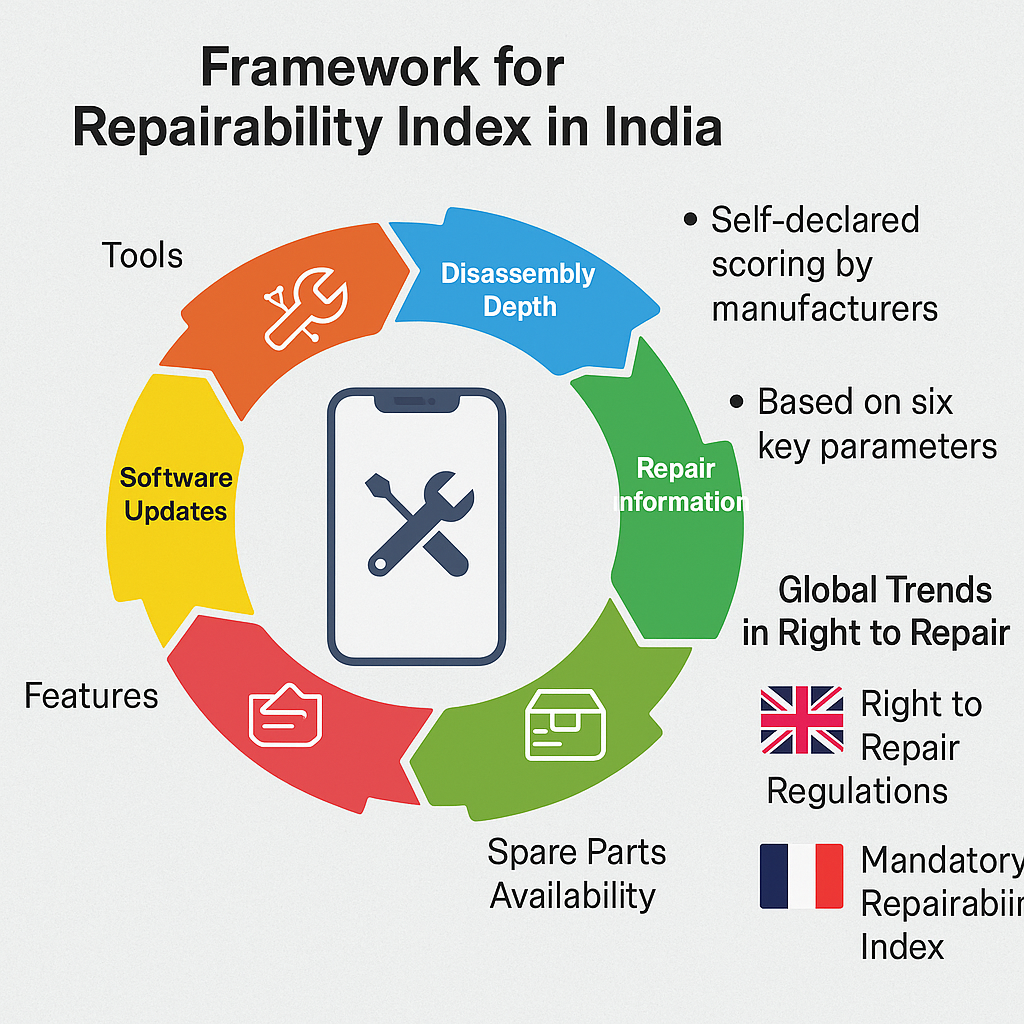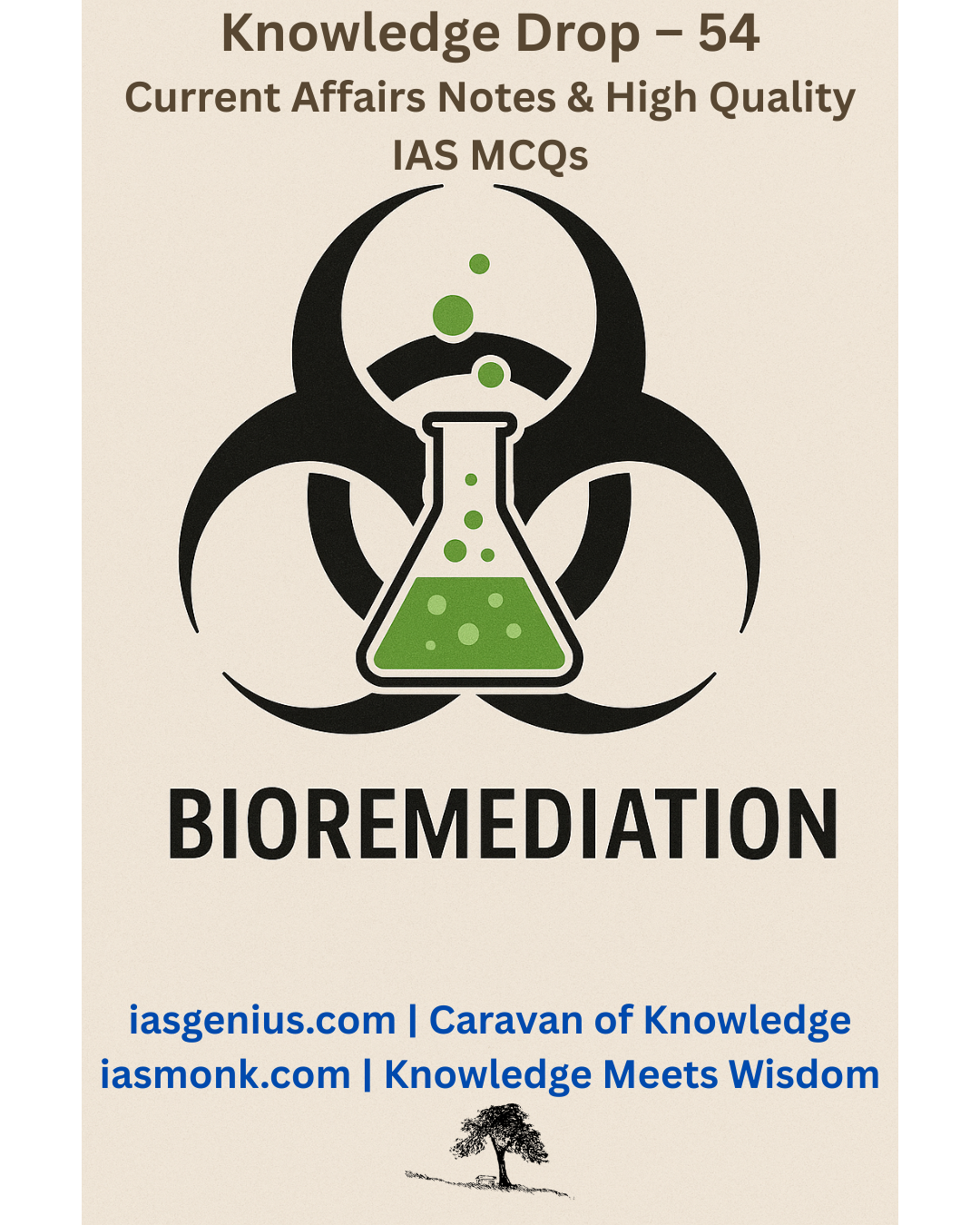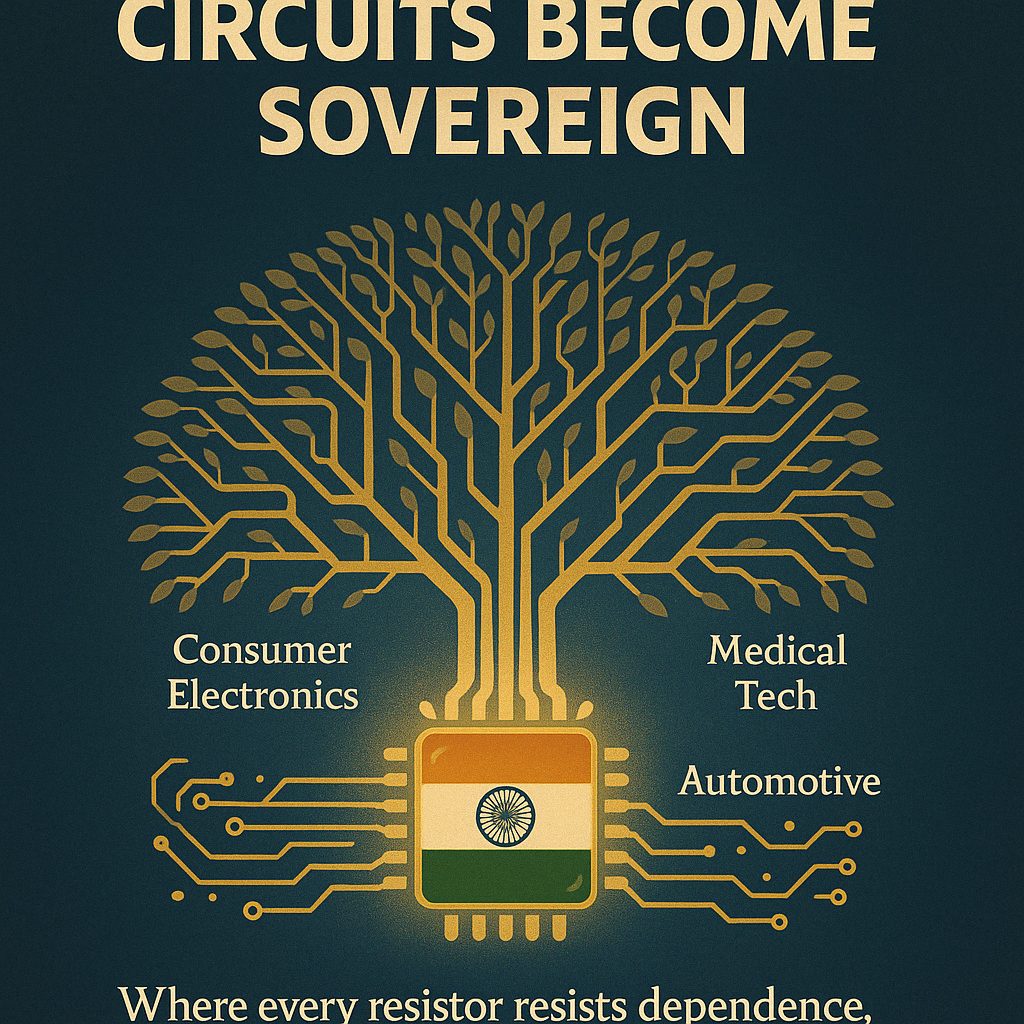
📅 May 6, 2025, Post 3: Fix It, Don’t Ditch It: India Proposes Repairability Index for Mobiles & Electronics | Mains Essay Attached | Target IAS-26 MCQs Attached: A complete Package, Dear Aspirants!
Fix It, Don’t Ditch It: India Proposes Repairability Index for Mobiles & Electronics

REPORTS & PROJECTS — PETAL 008
🗓️ May 6, 2025
Thematic Focus: Circular Economy ♻️ | Consumer Rights 📦 | Electronic Waste Management 🌍
📲 Opening Whisper
Before we bury another gadget, let us ask — was it truly broken, or just hidden behind a wall no one could fix?
Key Highlights
• The Committee on Framework for Repairability Index (RI) in Mobile and Electronics has submitted its report to the Department of Consumer Affairs (DoCA).
• This comes as India emerges as the third-largest e-waste generator globally, after China and the USA, driven by increased device consumption and limited repair options.
• From 2022 to 2025, consumer complaints about mobile phones and tablets rose by over 20%, reflecting a deeper need for repair access and product transparency.
• The committee, chaired by Bharat Khera, recommended introducing a self-declared Repairability Index by OEMs (Original Equipment Manufacturers), to be displayed on packaging, e-commerce platforms, and via QR codes.
🛠️ Core Components of the Repairability Index (RI)
As visualized in the attached graphic, the RI will score products based on six key parameters:
- Tools – Are specialized tools required?
- Disassembly Depth – How easy is it to take the device apart?
- Repair Information – Availability of manuals, guides
- Spare Parts Availability – Affordability and accessibility
- Features – How design impacts reparability
- Software Updates – Duration and ease of updates
🔧 Priority components include batteries, displays, speakers, and microphones — the most frequently damaged yet essential parts.
💡 Significance of the Framework
• E-Waste Reduction: Enables longer device life, reducing landfill waste
• Consumer Empowerment: Informs buyers at point-of-sale
• Local Economy Boost: Strengthens India’s repair ecosystem, supports job creation
• Circular Economy Model: Encourages reuse, aligns with SDG 12 (Responsible Consumption & Production)
🌍 Global Trends in Right to Repair
• France: Mandatory Repairability Index since 2021 on smartphones, TVs, laptops, and more
• UK: Right to Repair law mandates 10-year spare part availability for certain appliances
• India: Launched a Right to Repair Portal in 2022 covering:
1. Farming Equipment
2. Mobiles & Electronics
3. Consumer Durables
4. Automobile Equipment
⚠️ Challenges Ahead
• Technical Complexity: Modern devices are tightly integrated, requiring specialized training and tools
• OEM Resistance: Concerns over IP rights, performance risks, and tampering fears
• Consumer Awareness: Need for education on reading and using the Repairability Index effectively
🛣️ Way Forward
• Regulatory Support: Incorporate RI in future electronic manufacturing rules
• Standardization: Develop India-specific scoring system aligned with global norms
• MSME Enablement: Link repairability ratings with local repair certification programs
• Consumer Literacy Drives: Campaigns to help users make better, longer-lasting device choices
🧭 GS Paper Mapping
• GS Paper 2 – Governance & Consumer Rights
🔹 Right to Repair, digital consumer empowerment
• GS Paper 3 – Environment & Economy
🔹 E-waste management
🔹 Sustainable production and circular economy
💭 A Thought Spark — by IAS Monk
If buying is power, then fixing is freedom. The Right to Repair is not just about devices — it’s about democracy over the things we own, and the planet we borrow.
High Quality Mains Essay For Practice :
Word Limit 1000-1200
e-Waste and Its Management: Confronting the Digital Afterlife
Introduction: The Shadow Beneath the Screen
In an age where technology becomes obsolete faster than it can be understood, we are surrounded by a silent avalanche — electronic waste, or e-waste. Every smartphone discarded, every refrigerator retired, every chip replaced contributes to an ever-growing problem that lies at the intersection of progress and pollution. The very devices that power our modern lives now threaten to choke our environment, poison our soil, and fracture our public health systems.
e-Waste is not merely junk; it is a mirror to our consumption patterns, a challenge to sustainability, and a call for systemic reform. Effective e-waste management is no longer an environmental afterthought — it is a policy imperative, a business opportunity, and a moral responsibility.
I. What is e-Waste?
Electronic waste refers to discarded electrical and electronic equipment (EEE) and components — whether in working condition or not. It includes a vast range of devices:
- Consumer electronics: mobile phones, TVs, laptops
- Household appliances: refrigerators, washing machines, microwaves
- IT equipment, lighting, medical devices, solar panels, and more
What makes e-waste particularly hazardous is its composition — a complex mix of toxic heavy metals (lead, mercury, cadmium), rare earth elements, flame retardants, plastics, and occasionally radioactive elements.
II. The Growing Crisis: Global and Indian Scenario
🌍 Global Perspective
According to the Global e-Waste Monitor 2023:
- The world generated 62 million metric tonnes (MMT) of e-waste in 2022
- Only 17.4% was formally collected and recycled
- The rest was either landfilled, incinerated, or informally dismantled
🇮🇳 India’s Position
- India is the third-largest e-waste generator globally, after China and the USA
- It generated nearly 1.6 MMT of e-waste in 2021–22
- The informal sector handles over 90% of India’s e-waste, often in unsafe and polluting conditions
The proliferation of affordable gadgets, rising incomes, and urbanization have contributed to this surge — but policies and infrastructure for responsible disposal lag far behind.
III. Environmental and Health Hazards of e-Waste
• Soil and Water Contamination
– Improper disposal leads to leaching of toxic metals into groundwater and agricultural soil
– Dumpsites near rivers and wetlands cause long-term ecosystem damage
• Air Pollution
– Burning of circuit boards and plastics releases dioxins, furans, and carcinogenic gases
• Occupational Hazards
– Informal recyclers, often children and women, are exposed to lead, mercury, and cadmium, causing neurological, respiratory, and reproductive harm
• Loss of Valuable Resources
– Precious metals like gold, silver, palladium, and copper are lost due to crude recycling methods
IV. India’s Regulatory Framework for e-Waste Management
India has taken several steps to address this crisis:
🧾 E-Waste (Management) Rules, 2011 → Revised in 2016 and 2022
- Introduced Extended Producer Responsibility (EPR) — producers must collect and recycle their products
- Authorized formal dismantlers and recyclers
- 2022 Rules emphasize online tracking, refurbishing incentives, and reverse logistics
💻 Right to Repair Portal (2022)
- Offers information on repairing electronics, covering sectors like mobiles, farming equipment, and consumer durables
🔄 Repairability Index (2025, Draft Report)
- Proposes scoring consumer devices based on how easy they are to repair — reducing premature disposal
♻️ Circular Economy Initiatives
- Push for reuse, refurbishing, and modular designs across electronics industry
V. Challenges in e-Waste Management
🏚️ 1. Dominance of Informal Sector
– Lack of integration with formal systems
– Use of primitive, polluting techniques without protective gear
📉 2. Low Public Awareness
– Many consumers are unaware of recycling centres, collection mechanisms, or safe disposal practices
🏢 3. Industry Non-Compliance
– Producers often underreport e-waste or evade EPR targets
– Lack of third-party audits and weak enforcement
🚚 4. Inadequate Collection Infrastructure
– Scarcity of collection points in semi-urban and rural areas
– Poor reverse logistics networks
🔐 5. Data Security Concerns
– Reluctance to discard devices due to fears of data theft
VI. The Way Forward: Managing the Digital Afterlife
✅ 1. Strengthen EPR Compliance
– Introduce strict penalty mechanisms for producers
– Mandate third-party verification of recycled volumes
✅ 2. Formal–Informal Sector Integration
– Train and certify informal workers as part of authorized dismantling units
– Offer financial incentives and skill-building programs
✅ 3. Consumer Incentivization and Education
– Promote buyback schemes, repair discounts, and deposit refund systems
– Integrate e-waste education in school curriculums and public media
✅ 4. Technology for Tracking
– Use blockchain, QR codes, and e-waste registries to track product lifecycle
✅ 5. Design for Environment
– Encourage modular designs, longer warranties, and repairable hardware
Conclusion: The Responsibility We Cannot Reboot
We celebrate the device when it is born. But rarely do we mourn its death — or the trail it leaves behind. e-Waste is not just a by-product of modern life — it is its consequence. And managing it is not a choice; it is a necessity for planetary health, economic sustainability, and intergenerational equity.
If the 20th century was about electrifying the world, the 21st must be about ethically powering it down — one device, one law, one repair at a time.
Quote to End With
“A gadget discarded too soon is a planet scarred too deep. The future will not be built on what we buy — but on what we choose to repair.” — IAS Monk
Target IAS-26: Daily MCQs :
📌 Prelims Practice MCQs
Topic:
MCQ 1 – Type 1: How many of the following statements are correct?
Q. Consider the following statements regarding e-waste in India and globally:
• 1) India is the largest generator of e-waste in the world.
• 2) The informal sector handles more than 90% of India’s e-waste recycling.
• 3) e-Waste contains both toxic materials and valuable resources like gold and palladium.
• 4) India’s Right to Repair Portal was launched in 2022 and includes mobile phones and farming equipment.
Options:
A) Only two
B) Only three
C) All four
D) Only one
🌀 Didn’t get it? Click here (▸) for the Correct Answer & Explanation
✅ Correct Answer: B) Only three
🧠 Explanation:
• 1) ❌ Incorrect – India is the third-largest e-waste generator globally (after China and the USA).
• 2) ✅ Correct – Over 90% of e-waste in India is processed by the informal sector.
• 3) ✅ Correct – e-Waste includes toxic substances and precious metals like gold, silver, and palladium.
• 4) ✅ Correct – India launched the Right to Repair Portal in 2022, covering mobiles, electronics, farming tools, and consumer durables.
✅ So, only statements 2, 3, and 4 are correct.
MCQ 2 – Type 2: Two-Statement Based
Q. Consider the following statements about e-waste management in India:
• 1) India’s E-Waste (Management) Rules mandate Extended Producer Responsibility (EPR) for producers.
• 2) All electronic manufacturers in India are constitutionally required to provide 10-year spare part support.
Which of the above statements is/are correct?
A) Only 1 is correct
B) Only 2 is correct
C) Both are correct
D) Neither is correct
🌀 Didn’t get it? Click here (▸) for the Correct Answer & Explanation
✅ Correct Answer: A) Only 1 is correct
🧠 Explanation:
• 1) ✅ Correct – The EPR provision is part of India’s E-Waste Management Rules, requiring producers to collect and recycle e-waste.
• 2) ❌ Incorrect – No such constitutional requirement exists. The 10-year spare part mandate exists in the UK, not in India.
✅ Hence, only Statement 1 is correct.
MCQ 3 – Type 3: Which of the following statements is/are correct?
Q. Which of the following are part of India’s efforts to manage e-waste sustainably?
• 1) Introduction of Repairability Index (RI) in 2025 draft policy
• 2) Launch of National e-Waste Collection Hubs in every district
• 3) Integration of informal recyclers through training and certification
• 4) Creation of a Right to Repair Portal for consumer awareness
Options:
A) 1, 3, and 4 only
B) 1 and 4 only
C) 2, 3, and 4 only
D) All four
🌀 Didn’t get it? Click here (▸) for the Correct Answer & Explanation
✅ Correct Answer: A) 1, 3, and 4 only
🧠 Explanation:
• 1) ✅ Correct – A Repairability Index has been proposed in 2025 to inform consumers about product repair ease.
• 2) ❌ Incorrect – While desirable, there is no current national program to establish e-waste hubs in every district.
• 3) ✅ Correct – Policies recommend training informal workers to be integrated into formal systems.
• 4) ✅ Correct – The Right to Repair Portal was launched in 2022 to empower consumers.
✅ Hence, statements 1, 3, and 4 are correct.
MCQ 4 – Type 4: Direct Fact
Q. Which of the following metals is commonly found in printed circuit boards (PCBs) of e-waste?
A) Uranium
B) Gold
C) Tin
D) Lead
🌀 Didn’t get it? Click here (▸) for the Correct Answer & Explanation.
✅ Correct Answer: B) Gold
🧠 Explanation:
• Gold is a key component in printed circuit boards, due to its high conductivity and corrosion resistance.
• While lead and tin are also found, gold is especially targeted for urban mining during e-waste recycling.
✅ Correct answer: Gold.


















